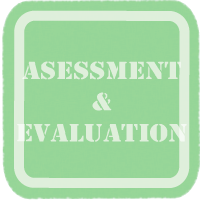 Using Rubrics for Assessment
Using Rubrics for Assessment
 There are many ways of assessing students’ work. What is important is that the assessment be consistent and fair for all students; they should all be being evaluated with the same scale and criteria. Using a rubric is an effective way to focus on certain aspects of the completed task. In this section we will examine what a rubric is and why they are often used in the classroom. There are many ways of assessing students’ work. What is important is that the assessment be consistent and fair for all students; they should all be being evaluated with the same scale and criteria. Using a rubric is an effective way to focus on certain aspects of the completed task. In this section we will examine what a rubric is and why they are often used in the classroom. |
|
What is a rubric?
A rubric is a tool used for assessment that identifies specific criteria to be assessed and gives numeric scores or descriptors for the levels of performance. Starting with the highest level and descending to the lowest, these levels of performance are used to assess the defined set of tasks as they relate to a final product or behavior. Each level describes degrees of proficiency and each level is assigned a value that rates the degree of proficiency of student performance. Rating scales are used; they can be numerical, qualitative, or a combination of numerical and qualitative.
To learn more basic information about rubrics, follow these links:
Understanding Rubrics (Heidi Goodrich Andrade)
Why are rubrics effective tools for assessing students?
The benefits of using a rubric are that it creates a more objective method of scoring; specific criteria are identified and the students are evaluated only on those criteria. Students can often be involved in the creation of a rubric in order to have a say in what they believe to be the most important aspects of the task; this can help with student motivation and investment. Even if students are not involved in the creation of the rubric, they should have a copy of it so they are aware of what is being assessed. This ensures fairness is maintained and pushes students to prepare to the best of their ability.
How can I create my own rubric?
Rubrics are easy to create; they can be made with word processing software and there are also generic web sites that allow you to input your information and the web site will format the rubric for you. Check out these web sites:
- http://www.rubrics4teachers.com/
- http://www.tools2learn.ca/rubric/rubric.html
- http://rubistar.4teachers.org/index.php
Don’t forget, there is no need to reinvent the wheel! Many of these sites have rubrics available that other teachers have created.
back to top

Virtual Assessment Center: Rubrics Overview
http://www.carla.umn.edu/assessment/VAC/evaluation/p_4.html



